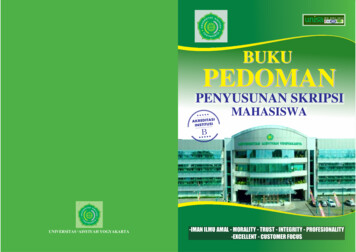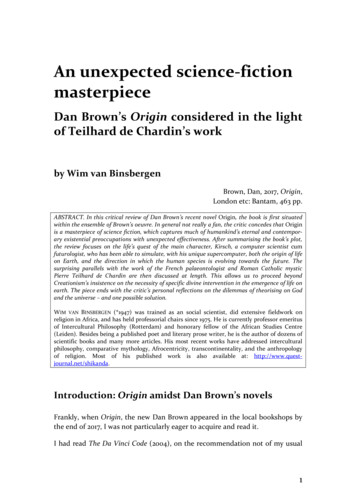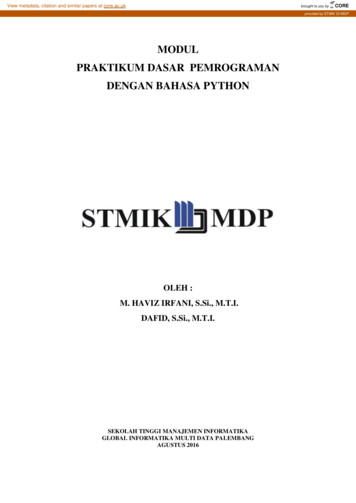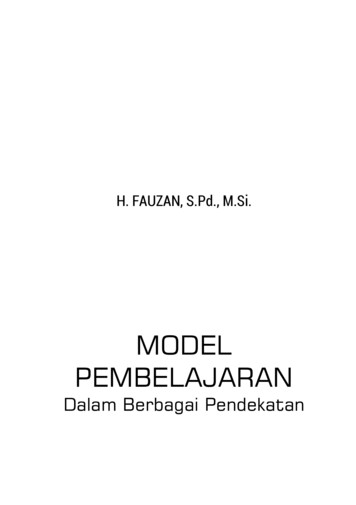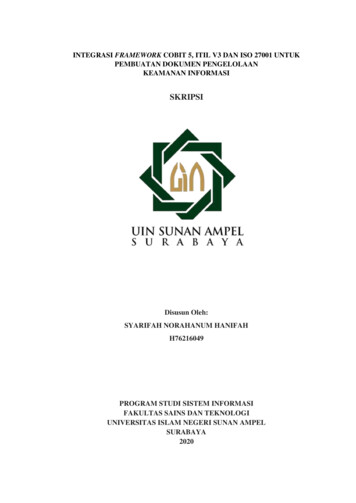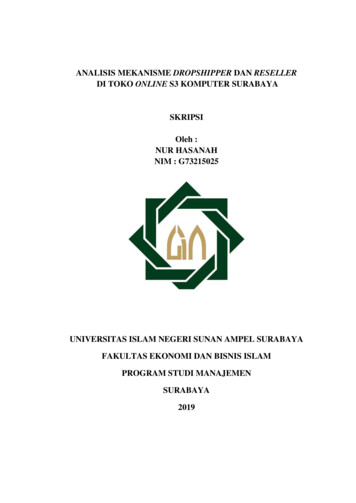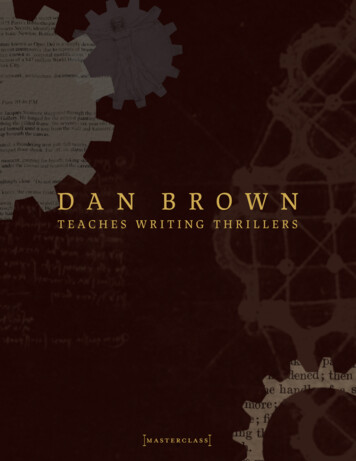
Transcription
D A NB R O W NTEACHES WRITING THRILLERSMASTERCLASS1MasterClass · 1
MEET YOUR INSTRUCTORDAN BROWNDan Brown is the author of numerous notablenovels, including The Da Vinci Code, which hasbecome one of the bestselling novels of all timeas well as the subject of intellectual debateamong readers and scholars. Brown’s novelsare published in 56 languages around the worldwith over 200 million copies in print.In 2005, Brown was named one of the 100Most Influential People in the World byTIME Magazine, whose editors credited himwith “keeping the publishing industry afloat;renewed interest in Leonardo da Vinci andearly Christian history; spiking tourism toParis and Rome; a growing membership insecret societies; the ire of Cardinals in Rome;eight books denying the claims of the novel andseven guides to read along with it; a flood ofhistorical thrillers; and a major motion picturefranchise.”The son of a mathematics teacher and a churchorganist, Brown was raised on a prep schoolcampus where he developed a fascination withthe paradoxical interplay between science andreligion. These themes eventually formed thebackdrop for his books. He is a graduate ofAmherst College and Phillips Exeter Academy,where he later returned to teach English beforefocusing his attention full time to writing. Helives in New England.Brown’s latest novel, Origin, explores two of thefundamental questions of humankind: Wheredo we come from? Where are we going?MasterClass · 2
Dear friends,Storytelling is the oldest art form on earth, and whetheryou’re a fan of thrillers, classics, literary fiction, or evenancient myths, the stories you love all share the same keyelements.Understanding these universal components is one of thesecrets to making your own writing much more effective andsuccessful. It can also make the writing process a lot more fun.In this class, I hope to unlock for you a toolbox of ideas thatyou can use immediately as you write your own novel. It isthe same toolbox I used to write The Da Vinci Code and all ofmy books. My sincere desire is that this class inspires in youa passion for the writing process as well as the confidenceto master your own personal voice and create a story that isdistinctly your own.And with luck, we might just have some fun along the way.See you in class,MasterClass · 3
MASTERCLASSCHAPTER ONEINTRODUCTIONDAN BROWN“At the end of this MasterClass, I am going toadmit something to you that I have never admittedto anyone on Earth. I’m also going to show you anartifact that nobody except me has ever seen. Andthat is your first lesson in suspense.”MasterClass · 4
DAN BROWNCHAPTER ONEINTRODUCTIONChapter ReviewStorytelling is the oldest human art form.Whether spoken, or in a book, or in a painting,or even in a piece of music, storytelling hasalways had at its core a single consistentambition: to capture and sustain our attention.In this class, Dan will discuss this critical element of storytelling and show how it applies towriting novels. He’ll share the techniques thathe used to build his own novels—suspense, plot,action, research, and character development—and demonstrate how he uses these tools toserve the specific goal of keeping the readerengaged.If you’ve ever taken a writing class, you’veprobably heard the familiar advice: “Writewhat you know” and “Show, don’t tell.” Whilethese maxims can be helpful, they won’t getyou through the complicated task of writinga novel. Dan acquired his tools the way mostwriters do: by reading books and writing hisown. But as a writer who has successfullypracticed sustaining a reader’s attention overthe course of seven novels, his advice goes wellbeyond using writerly sleight-of-hand to buildsuspense. It involves finding your individualpassions, understanding the nuances of depicting a world, developing specific research techniques, and learning skills that allow surprisingconnections to be made between your plot linesand characters.Because this class involves a lot of nuts-andbolts advice, Dan often uses specific examplesfrom his own works. Some of the examplescontain spoilers. Before you get started, it’s agood idea to read the following of his novels:Digital Fortress (1998), The Da Vinci Code (2003),The Lost Symbol (2009), Inferno (2013), andOrigin (2017).Learn MoreThroughout the course, you’ll hear the term“thriller” applied in its broadest sense to meannovels of suspense. Although this is a modernterm, thrillers have existed throughout history.Examples range from Homer’s Odyssey (c. 725BCE) through fairy tales and folklore right upto the genre’s first popular novel, AlexandreDumas’ The Count of Monte Cristo (1844). Today’s category has become sprawling enough tocontain numerous subtypes, such as espionage,legal, political, crime, psychological, and science fiction. Any book can generate excitement,suspense, interest, and exhilaration, but because these are the primary goals of the thrillergenre, its authors have a laser-focused expertise in keeping a reader interested. So whether you’re writing a thriller or just looking toborrow from the toolbox, the techniques of thisclass can help you.Check out National Public Radio’s list of topthrillers or turn to any of the classic novelsbelow for examples that blend thriller elementsinto other genres.Frankenstein (1818) by Mary ShelleyWuthering Heights (1847) by Emily BrontëThe Woman in White (1860) by Wilkie CollinsTreasure Island (1883) by Robert LouisStevensonThe Turn of the Screw (1898) by Henry JamesBrave New World (1932) by Aldous HuxleyMasterClass · 5
INTRODUCTIONDAN BROWNRebecca (1938) by Daphne du Maurier.Invisible Man (1952) by Ralph EllisonLolita (1955) by Vladimir NabokovTo Kill a Mockingbird (1960) by Harper LeeOne Flew Over the Cuckoo’s Nest (1962)by Ken KeseyWriting ExercisesThe coursework offered in this book is dividedinto two sections. Writing Exercises arefor everyone, offering ways to practice the skillsDan teaches in the video lessons. The For YourNovel section is tailored to writers who wantto begin or are already at work on a novel. Thissection applies the lessons to the overall process ofdeveloping a book-length work.CHAPTER ONEIn her book of writing advice, Writing Downthe Bones (1986), Natalie Goldberg says “Talkis the exercise ground for writing.” All of ustell stories whenever we talk. Think of threerecent examples when someone has saidsomething that caught your interest. Thiscould be anything from a casual conversationwith a co-worker to a tragic event you heardabout on the nightly news. Write these threestories—no matter how short they are—inyour notebook and record the followingthings about each one: the exact moment thatyou became interested in the story, why youwere interested, and, once your interest waspiqued, what more you wanted to know.Keep a notebook devoted solely to this course.Many of the assignments build on previous onesand will lead you through the process of findingyour setting, developing characters, building astory, and researching your subject matter. Ifyou’ve already finished a novel, you can jumpin at any point to strengthen your work. Danprovides an abundance of practical advice thatwill help you understand how to keep yourreader’s attention up until the very last page.MasterClass · 6
MASTERCLASSCHAPTER twoTHE ANATOMY OFA THRILLERDAN BROWN“Suspense is all about making promises. It’s about tellinga reader, ‘I know something you don’t know. And Ipromise, if you turn the page, I’m going to tell you.’”MasterClass · 7
DAN BROWNCHAPTER TWOT H E A N AT O M Y O F A T H R I L L E RsubchaptersThe Elements of a StoryThe Three C’sPace, Promises, SuspenseFirst, Read CriticallyChapter ReviewSuspense begins with the three C’s:the contract, the clock, and the crucible.The contract is an implied promise you maketo the reader about what will be delivered bythe end of the book. The contract in Moby Dick(1851) for example, is that the reader will findout whether or not Ahab has caught the whale.In any novel, there are hundreds of promises,small and large. It is crucial in storytelling thatyou keep every single promise you have made,no matter how trivial. If you’ve suggested thatyour protagonist wants to buy a little blackdress, by the end we’ve got to see her buy oneor understand why she didn’t.Clock refers to the fact that adding timepressure to any character’s struggle will createhigher stakes and more interest for your reader.There are thousands of ways to add time pressure—it will depend on your characters andtheir world—but don’t be afraid to use standard“clock” elements like ticking bombs or villainswho manage to stay one step ahead. The goal ofthis element is not to be stunningly original butto invest your story with a pressure that willprompt conflicts and intense responses fromyour characters.Think of the crucible as a box that constrainsyour characters, offers them no escape, andforces them to act. Your story should presentan increasingly difficult series of tasks andsituations for the hero that will funnel him intothe most severe trial of all. You must make surethat each successive task is harder than theprevious one and that, for the hero, there is noescape. If readers begin to sense that the journey is becoming easier, they will lose interest.Keeping a reader’s attention means makingpromises and fulfilling them. Dan’s preferredstyle is to make a lot of promises early in thenovel and to deliver on them quickly. In orderto sustain attention, he resolves one promiseand then makes another simultaneously. Heaccomplishes this with short chapters andtightly-focused scenes. This creates a kind ofpatchwork of promises that are laid downthroughout the narrative. In order for this to beeffective, the promises must have a clock effect(something must be hurrying the charactersalong) as well as a crucible effect (they mustincrease in intensity, and the reader must feelthat they are leading to an ultimate and coherent objective).People often define thrillers as novels of highstakes and suspense, but these elements existin every story. You don’t need a nuclear bombto create high stakes. Whatever the stakesare, they need to be high for your protagonist.Perhaps your hero is trying to save his restaurant from closing, or he’s trying to keep hisMasterClass · 8
DAN BROWNTHE ANATOMY OF A THRILLERchild out of prison. The things that compelyour protagonist will become gripping to yourreader. What makes a book a thriller is the paceat which the promises are kept. Questions youraise for the reader are often answered quicklyand will lead to more questions. The questionswith the biggest stakes are revealed moreslowly throughout the course of the novel.Dan emphasizes reading as a critical step inbecoming a great writer. You might read tolearn, to enjoy a story, or to look for inspiration, but when you start to write a novel, youshould begin reading with a critical eye. Studyhow other writers are practicing the craft. Findthe things that thrill you, and learn from thethings that don’t. Pay attention to the way yourfavorite novels are put together. You’ll be usingall this information in crafting your own novel.Learn MoreOne of Dan’s primary influences is RobertLudlum’s Bourne Identity (1980). It serves asan example of the power of a simple promise:Jason Bourne has amnesia—will he find outwho he is? If you have the time, treat yourselfto a weekend curled up with the originalBourne Trilogy. In particular, study howLudlum uses his premise to generate so manycomplicated and riveting situations.The Bourne Identity (1980)The Bourne Supremacy (1986)The Bourne Ultimatum (1990)CHAPTER TWOas a threat not only to his life but to the livesof others whom he cares about). The cruciblemeans that things are going to get even moremiserable for Langdon, and there is only oneway out—and that is to face the villain. Readthe first few chapters of Inferno (2013), reproduced on the following pages, and note thepromises and how quickly they are fulfilled (ornot). What creates the time pressure? And howdoes Dan create the sense that Langdon is beingforced into a confrontation with his antagonist?For more information on when and how tomake promises and reveal information, readMastering Suspense, Structure, and Plot (2016)by award-winning author Jane K. Cleland. Janetakes a close look at what sorts of informationshould be revealed at what speed, and she offersvarious techniques to do that.The clock is a central feature in most thrillers.For a comprehensive look at a variety of timepressure devices, check out the first season of24 (2001), a television show renowned for its real-time pacing and edge-of-your-seat suspense.In your notebook, make a list of the ways inwhich the show creates pressure for its characters. Are you using any of these techniques inyour writing? Which ones are your favorites?For a fun look at the crucible aspect of thrillers,scan through these common “escape tropes”compiled by TVTropes and consider which, ifany, you have used or would like to play aroundwith in your own story.Dan’s novel Inferno (2013) opens with Langdonbeing pursued by an assassin. Applying thecrucible means that for the rest of the novel,Langdon’s life must continue to be in danger. Ifit is no longer in danger, then that tension mustbe replaced by an even bigger danger (suchMasterClass · 9
THE ANATOMY OF A THRILLERDAN BROWNWriting ExercisesIn your notebook, go back to the three storiesfrom the assignment in Chapter 1: Introduction(or use your novel-in-progress). Choose one ofthe stories and apply the three C’s to it, answering the following questions:What was the contract in the story? How slowlyor quickly was information revealed? Did youever grow bored by the story? Did new promises emerge during the telling of the story?What sort of time pressure exists in the tale?Did the narrative grow more intense, or did itfalter?Now re-write the story according to the anatomy of a thriller. Add in promises, create a timepressure, and refine the crucible to heat thingsup.MasterClass · 10CHAPTER TWO
DAN BROWNTHE ANATOMY OF A THRILLERCHAPTER TWOAN EXCERPT FROMINFERNODan BrownCHAPTER 1The memories materialized slowly like bubblessurfacing from the darkness of a bottomless well.A veiled woman.Robert Langdon gazed at her across a river whosechurning waters ran red with blood. On the farbank, the woman stood facing him, motionless, solemn, her face hidden by a shroud. In her hand shegripped a blue tainia cloth, which she now raised inhonor of the sea of corpses at her feet. The smell ofdeath hung everywhere.Seek, the woman whispered. And ye shall find.Langdon heard the words as if she had spokenthem inside his head. “Who are you?” he called out,but his voice made no sound.Time grows short, she whispered. Seek and find.Langdon took a step toward the river, but hecould see the waters were bloodred and too deepto traverse. When Langdon raised his eyes again tothe veiled woman, the bodies at her feet had multiplied. There were hundreds of them now, maybethousands, some still alive, writhing in agony, dyingunthinkable deaths consumed by fire, buried infeces, devouring one another. He could hear themournful cries of human suffering echoing acrossthe water.The woman moved toward him, holding out herslender hands, as if beckoning for help.“Who are you?!” Langdon again shouted.In response, the woman reached up and slowlylifted the veil from her face. She was strikinglybeautiful, and yet older than Langdon hadimagined—in her sixties perhaps, stately andstrong, like a timeless statue. She had a sternly setjaw, deep soulful eyes, and long, silver-gray hair thatcascaded over her shoulders in ringlets. An amuletof lapis lazuli hung around her neck—a single snakecoiled around a staff.Langdon sensed he knew her trusted her. Buthow? Why?She pointed now to a writhing pair of legs, whichprotruded upside down from the earth, apparentlybelonging to some poor soul who had been buriedheadfirst to his waist. The man’s pale thigh bore asingle letter—written in mud—R.R? Langdon thought, uncertain. As in Robert? “Isthat me?”The woman’s face revealed nothing. Seek and find,she repeated.Without warning, she began radiating a whitelight brighter and brighter. Her entire bodystarted vibrating intensely, and then, in a rush ofthunder, she exploded into a thousand splinteringshards of light.Langdon bolted awake, shouting.The room was bright. He was alone. The sharpsmell of medicinal alcohol hung in the air, andsomewhere a machine pinged in quiet rhythm withhis heart. Langdon tried to move his right arm, buta sharp pain restrained him. He looked down andsaw an IV tugging at the skin of his forearm.His pulse quickened, and the machines kept pace,pinging more rapidly.MasterClass · 11
DAN BROWNTHE ANATOMY OF A THRILLERWhere am I? What happened?The back of Langdon’s head throbbed, a gnawingpain. Gingerly, he reached up with his free arm andtouched his scalp, trying to locate the source of hisheadache. Beneath his matted hair, he found thehard nubs of a dozen or so stitches caked with driedblood.He closed his eyes, trying to remember anaccident.Nothing. A total blank.Think.Only darkness.A man in scrubs hurried in, apparently alertedby Langdon’s racing heart monitor. He had ashaggy beard, bushy mustache, and gentle eyes thatradiated a thoughtful calm beneath his overgrowneyebrows.“What happened?” Langdon managed. “Did Ihave an accident?”The bearded man put a finger to his lips and thenrushed out, calling for someone down the hall.Langdon turned his head, but the movementsent a spike of pain radiating through his skull. Hetook deep breaths and let the pain pass. Then, verygently and methodically, he surveyed his sterilesurroundings.The hospital room had a single bed. No flowers.No cards. Langdon saw his clothes on a nearbycounter, folded inside a clear plastic bag. They werecovered with blood.My God. It must have been bad.Now Langdon rotated his head very slowly towardthe window beside his bed. It was dark outside.Night. All Langdon could see in the glass was hisown reflection—an ashen stranger, pale and weary,attached to tubes and wires, surrounded by medicalequipment.Voices approached in the hall, and Langdonturned his gaze back toward the room. The doctorreturned, now accompanied by a woman.CHAPTER TWOShe appeared to be in her early thirties. She woreblue scrubs and had tied her blond hair back in athick ponytail that swung behind her as she walked.“I’m Dr. Sienna Brooks,” she said, giving Langdona smile as she entered. “I’ll be working with Dr.Marconi tonight.”Langdon nodded weakly.Tall and lissome, Dr. Brooks moved with theassertive gait of an athlete. Even in shapeless scrubs,she had a willowy elegance about her. Despite theabsence of any makeup that Langdon could see, hercomplexion appeared unusually smooth, the onlyblemish a tiny beauty mark just above her lips. Hereyes, though a gentle brown, seemed unusuallypenetrating, as if they had witnessed a profundityof experience rarely encountered by a person herage.“Dr. Marconi doesn’t speak much English,” shesaid, sitting down beside him, “and he asked me tofill out your admittance form.” She gave him another smile.“Thanks,” Langdon croaked.“Okay,” she began, her tone businesslike. “What isyour name?”It took him a moment. “Robert Langdon.”She shone a penlight in Langdon’s eyes.“Occupation?”This information surfaced even more slowly.“Professor. Art history and symbology.Harvard University.”Dr. Brooks lowered the light, looking startled.The doctor with the bushy eyebrows looked equallysurprised.“You’re an American?”Langdon gave her a confused look.“It’s just ” She hesitated. “You had no identification when you arrived tonight. You were wearingHarris Tweed and Somerset loafers, so we guessedBritish.”MasterClass · 12
DAN BROWNTHE ANATOMY OF A THRILLER“I’m American,” Langdon assured her, too exhausted to explain his preference for well-tailoredclothing.“Any pain?”“My head,” Langdon replied, his throbbing skullonly made worse by the bright penlight.Thankfully, she now pocketed it, taking Langdon’swrist and checking his pulse.“You woke up shouting,” the woman said. “Do youremember why?”Langdon flashed again on the strange vision of theveiled woman surrounded by writhing bodies. Seekand ye shall find. “I was having a nightmare.”“About?”Langdon told her.Dr. Brooks’s expression remained neutral as shemade notes on a clipboard. “Any idea what mighthave sparked such a frightening vision?”Langdon probed his memory and then shook hishead, which pounded in protest.“Okay, Mr. Langdon,” she said, still writing, “acouple of routine questions for you. What day of theweek is it?”Langdon thought for a moment. “It’s Saturday. Iremember earlier today walking across campus going to an afternoon lecture series, and then that’s pretty much the last thing I remember. Did Ifall?”“We’ll get to that. Do you know where you are?”Langdon took his best guess. “MassachusettsGeneral Hospital?”Dr. Brooks made another note. “And is theresomeone we should call for you? Wife?Children?”“Nobody,” Langdon replied instinctively. He hadalways enjoyed the solitude and independenceprovided him by his chosen life of bachelorhood,although he had to admit, in his current situation,he’d prefer to have a familiar face at his side. “Thereare some colleagues I could call, but I’m fine.”CHAPTER TWODr. Brooks finished writing, and the older doctorapproached. Smoothing back his bushy eyebrows, heproduced a small voice recorder from his pocket andshowed it to Dr.Brooks. She nodded in understanding and turnedback to her patient.“Mr. Langdon, when you arrived tonight, you weremumbling something over and over.”She glanced at Dr. Marconi, who held up thedigital recorder and pressed a button.A recording began to play, and Langdon heard hisown groggy voice, repeatedly muttering the samephrase: “Ve sorry. Ve sorry.”“It sounds to me,” the woman said, “like you’resaying, ‘Very sorry. Very sorry.’ ”Langdon agreed, and yet he had no recollection ofit.Dr. Brooks fixed him with a disquietingly intensestare. “Do you have any idea why you’d be sayingthis? Are you sorry about something?”As Langdon probed the dark recesses of his memory, he again saw the veiled woman.She was standing on the banks of a bloodred riversurrounded by bodies. The stench of death returned.Langdon was overcome by a sudden, instinctivesense of danger not just for himself but for everyone. The pinging of his heart monitor acceleratedrapidly. His muscles tightened, and he tried to sit up.Dr. Brooks quickly placed a firm hand onLangdon’s sternum, forcing him back down.She shot a glance at the bearded doctor, whowalked over to a nearby counter and began preparing something.Dr. Brooks hovered over Langdon, whisperingnow. “Mr. Langdon, anxiety is common with braininjuries, but you need to keep your pulse rate down.No movement. No excitement. Just lie still and rest.You’ll be okay. Your memory will come back slowly.”MasterClass · 13
DAN BROWNTHE ANATOMY OF A THRILLERThe doctor returned now with a syringe, which hehanded to Dr. Brooks. She injected its contents intoLangdon’s IV.“Just a mild sedative to calm you down,” she explained, “and also to help with the pain.” She stoodto go. “You’ll be fine, Mr. Langdon. Just sleep. If youneed anything, press the button on your bedside.”She turned out the light and departed with thebearded doctor.In the darkness, Langdon felt the drugs washingthrough his system almost instantly, dragging hisbody back down into that deep well from which hehad emerged. He fought the feeling, forcing his eyesopen in the darkness of his room. He tried to sit up,but his body felt like cement.As Langdon shifted, he found himself again facingthe window. The lights were out, and in the darkglass, his own reflection had disappeared, replacedby an illuminated skyline in the distance.Amid a contour of spires and domes, a singleregal facade dominated Langdon’s field of view.The building was an imposing stone fortress witha notched parapet and a three hundred-foot towerthat swelled near the top, bulging outward into amassive machicolated battlement.Langdon sat bolt upright in bed, pain exploding inhis head. He fought off the searing throb and fixedhis gaze on the tower.CHAPTER TWOLangdon knew the medieval structure well.It was unique in the world.Unfortunately, it was also located four thousandmiles from Massachusetts.—Outside his window, hidden in the shadows of theVia Torregalli, a powerfully built woman effortlesslyunstraddled her BMW motorcycle and advancedwith the intensity of a panther stalking its prey. Hergaze was sharp. Her close-cropped hair—styled intospikes—stood out against the upturned collar of herblack leather riding suit. She checked her silencedweapon, and stared up at the window where RobertLangdon’s light had just gone out.Earlier tonight her original mission had gonehorribly awry.The coo of a single dove had changed everything.Now she had come to make it right.MasterClass · 14
DAN BROWNTHE ANATOMY OF A THRILLERCHAPTER TWOCHAPTER 2I’m in Florence!?Robert Langdon’s head throbbed. He was now seated upright in his hospital bed, repeatedly jamminghis finger into the call button. Despite the sedativesin his system, his heart was racing.Dr. Brooks hurried back in, her ponytail bobbing.“Are you okay?”Langdon shook his head in bewilderment. “I’m in Italy!?”“Good,” she said. “You’re remembering.”“No!” Langdon pointed out the window at thecommanding edifice in the distance. “I recognize thePalazzo Vecchio.”Dr. Brooks flicked the lights back on, and theFlorence skyline disappeared. She came to hisbedside, whispering calmly. “Mr. Langdon, there’s noneed to worry. You’re suffering from mild amnesia,but Dr. Marconi confirmed that your brain functionis fine.”The bearded doctor rushed in as well, apparentlyhearing the call button. He checkedLangdon’s heart monitor as the young doctorspoke to him in rapid, fluent Italian— somethingabout how Langdon was “agitato” to learn he was inItaly.Agitated? Langdon thought angrily. More likestupefied! The adrenaline surging through his system was now doing battle with the sedatives. “Whathappened to me?” he demanded. “What day is it?!”“Everything is fine,” she said. “It’s early morning.Monday, March eighteenth.”Monday. Langdon forced his aching mind to reelback to the last images he could recall—cold anddark—walking alone across the Harvard campusto a Saturday-night lecture series. That was twodays ago?! A sharper panic now gripped him as hetried to recall anything at all from the lecture orafterward. Nothing. The ping of his heart monitoraccelerated.The older doctor scratched at his beard and continued adjusting equipment while Dr.Brooks sat again beside Langdon.“You’re going to be okay,” she reassured him,speaking gently. “We’ve diagnosed you with retrograde amnesia, which is very common in headtrauma. Your memories of the past few days maybe muddled or missing, but you should suffer nopermanent damage.”She paused. “Do you remember my first name? Itold you when I walked in.”Langdon thought a moment. “Sienna.” Dr. SiennaBrooks.She smiled. “See? You’re already forming newmemories.”The pain in Langdon’s head was almost unbearable, and his near-field vision remained blurry.“What happened? How did I get here?”“I think you should rest, and maybe—”“How did I get here?!” he demanded, his heartmonitor accelerating further.“Okay, just breathe easy,” Dr. Brooks said, exchanging a nervous look with her colleague. “I’ll tellyou.” Her voice turned markedly more serious. “Mr.Langdon, three hours ago, you staggered into ouremergency room, bleeding from a head wound, andyou immediately collapsed. Nobody had any ideawho you were or how you got here. You were mumbling in English, so Dr. Marconi asked me to assist.I’m on sabbatical here from the U.K.”MasterClass · 15
DAN BROWNTHE ANATOMY OF A THRILLERLangdon felt like he had awoken inside a MaxErnst painting. What the hell am I doing in Italy?Normally Langdon came here every other June foran art conference, but this was March.The sedatives pulled harder at him now, and hefelt as if earth’s gravity were growing stronger bythe second, trying to drag him down through hismattress. Langdon fought it, hoisting his head,trying to stay alert.Dr. Brooks leaned over him, hovering like anangel. “Please, Mr. Langdon,” she whispered. “Headtrauma is delicate in the first twenty-four hours. Youneed to rest, or you could do serious damage.”A voice crackled suddenly on the room’s intercom.“Dr. Marconi?”The bearded doctor touched a button on the walland replied, “Sì?”The voice on the intercom spoke in rapid Italian.Langdon didn’t catch what it said, but he did catchthe two doctors exchanging a look of surprise. Or isit alarm?“Momento,” Marconi replied, ending theconversation.“What’s going on?” Langdon asked.Dr. Brooks’s eyes seemed to narrow a bit. “Thatwas the ICU receptionist. Someone’s here to visityou.”A ray of hope cut through Langdon’s grogginess.“That’s good news! Maybe this person knows whathappened to me.”She looked uncertain. “It’s just odd that someone’shere. We didn’t have your name, and you’re not evenregistered in the system yet.”Langdon battled the sedatives and awkwardlyhoisted himself upright in his bed. “If someoneknows I’m here, that person must know whathappened!”Dr. Brooks glanced at Dr. Marconi, who immediately shook his head and tapped his watch. Sheturned back to Langdon.CHAPTER TWO“This is the ICU,” she explained. “Nobody isallowed in until nine A.M. at the earliest. In amoment Dr. Marconi will go out and see who thevisitor is and what he or she wants.”“What about what I want?” Langdon demanded.Dr. Brooks smiled patiently and lowered her voice,leaning closer. “Mr. Langdon, there are some thingsyou don’t know about last night about whathappened to you. And before you speak to anyone, Ithink it’s only fair that you have all the facts.Unfortunately, I don’t think you’re strong enoughyet to—”
Dan Brown is the author of numerous notable novels, including The Da Vinci Code, which has become one of the bestselling novels of all time as well as the subject of intellectual debate among readers and scholars. Brown's novels are published in 56 languages around the world with over 200 million copies in print. In 2005, Brown was named one .
